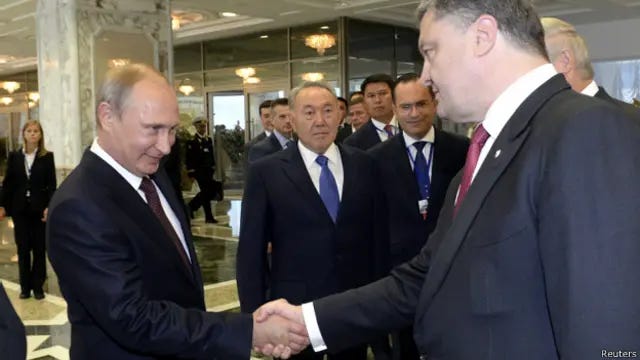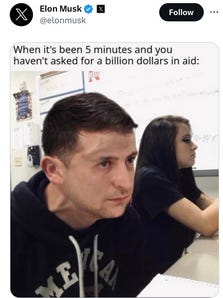A Decade of Peace in Ukraine
This generation's worst diplomatic failure and how it might happen again
Imagine yourself a Ukrainian soldier, defending a small but crucial Donbas town from relentless attacks by numerically superior Russian forces. You are exhausted from the months of fighting, as well as the malignant cold of the February steppe. For every three repelled Russian assaults, one succeeds. The situation deteriorates daily. In the meantime, when guns fall silent, there starts a great buzz about the negotiations with the Russians, a settlement supposedly coming any day now. You are not sure how you feel about it - how do you negotiate with chronic liars and murderers? What “peace” can you expect from someone who longs for your destruction? And all this resistance, was it for nothing? What did your friends die for? What will be the conditions? And what if it doesn’t work? What if this happens again?”
You look at the calendar. The date is February 17th, 2015.
You cross it out with a marker.

Despite a remarkably eventful decade passing by, Ukraine now finds itself in an eerily and frustratingly similar position to where it was in February 2015. The front holds, but by a tiny thread, and seemingly every day you see Russian officials gloating about the horrors they’ll commit if they break through. A gigantic force of what can easily be called a mercenary army slowly grinds forward. Meanwhile, the predominantly mobilized Ukrainian forces lack both the manpower and firepower to stop them.
As in 2015, there is also political pressure coming from the West. In the US, the Obama administration confirmed their commitment to supporting Ukraine by sending millions in supplies, but stubbornly refused to send lethal aid, a question which gnawed at Obama’s administration. More broadly, both the US and Europe wanted the war to end so they could resume their relations with Russia. This is a sentiment that still holds much of Europe in its sway.
After the full-scale invasion in 2022 the Biden administration had finally changed their policy on lethal aid, but this birthed another political problem - Russian and Republican propaganda portrayed this support as a corrupt deal with a crew of oligarchs, sending them tens of millions dollars while in the US there was poverty/homelessness/failing infrastructure. This worked on a lot of people. The Trump administration has turned everything on its head - today, they began talks with Russia in Saudi Arabia without even inviting Ukraine to the process.
Meanwhile Europe has finally started to understand the lessons of this decade. The hold that Russian gas had on European governments is over. As Russians sabotage infrastructure across the continent and the US turns isolationalist, Europe has little choice other than finally starting to take their own defence seriously. Now it seems that EU will have to take America’s place in the support of Ukraine. Many European countries (the Baltics, Denmark, the Netherlands) already see the situation for what it is, and support Ukraine far more than their counterparts per capita. However, there are some holdouts like Germany and some governments like Orban’s or Fico’s that have taken Russia’s side.

At this point it must be clear that negotiations with Russia are nothing more than Russia legitimizing its conquests. The talks in Minsk from September to February 2014-15 were not the first. In fact, it was part of a sort of formulaic pattern. On April 18th 2014, several days after the fighting in Donbas began, a ceasefire was declared following talks in Geneva. That ceasefire held for several days and gave the Russian paramilitaries time to consolidate their positions. It was over when the police found a local pro-Ukrainian politician on a riverbank, gutted like a fish.
On June 20th, the Poroshenko government declared a domestically maligned unilateral ceasefire following western pressure. It was declared just as Ukraine finally seized the initiative and started beating the Russians back. This ceasefire was a political and military disaster. It again gave the Russians time to reorganize as Russia began supplying the paramilitaries with tanks and IFVs. There was one particularly nasty attack on the Ukrainian forces that increased the public’s frustration with this ceasefire. After extending it to the end of the month, it was finally over on July 1st.
On September 5th the representatives of Ukraine, Russia and OSCE released the Minsk protocols, supposed to end the fighting. In it, the Donbas was officially split into Ukrainian and Russian-held areas according to the frontline at the time. This followed another turning point in the conflict after the Russian military invaded Donbas itself in August.

I will not go into detail on the protocol here (there will be a seperate article on the details of the protocol later). It mattered little as heavy fighting continued along the entire frontline, with one hotspot being the infamous Battle of Donetsk Airport. After the Ukrainian forces there were destroyed along with the airport in January 2015, Russian paramilitaries and army forces reoriented to the Ukrainian-held Debaltseve, a crucial transport hub. Fighting around Debaltseve intensified by the end of January, as talks in Minsk resumed in full capacity.

“I quickly understood that Putin only wanted to win some time, […] so that his military forces would take additional positions.” These are the words of former French president Francois Hollande, who was present at the table in February along with German Chancellor Angela Merkel, Vladimir Putin, President Poroshenko and others. “Many times Poroshenko and Putin raised their voices at each other. The latter sudenly became angry and threatened Poroshenko with total and complete destruction of the Ukrainian forces. This looked like an admission of the presence of Russian troops in eastern Ukraine. Putin quickly gathered himself," Hollande writes in his memoir.
The main point of contention was the status of the Russian-held areas. Putin wanted these areas to be legally within Ukraine, but still ruled by his warlords. The intention there was that the Donbas would be a trojan horse for Ukrainian politics and stability that Russia could exploit at the time of their choosing. However, the leaders of the so-called Donetsk & Luhansk People’s Republics were wanted by Ukrainian courts for the many crimes comitted under their watch. Ukraine wouldn’t bulge on the full return of the occupied areas, as is still the case today.

Nonetheless, agreement was reached on other points of the protocol and ceasefire was declared on February 12th, though it was as if it didn’t happen - Russian military continued their assault on Debaltseve until the Ukrainian forces retreated from the area on February 18th. A final ceasefire was declared on the 20th.
But the so-called Minsk Agreements did not stop the fighting. War continued to ruin the Donbas, but with a little less intensity - so that fewer headlines would be generated on the Russian presence in Ukraine. Nonetheless, Russian forces would launch another attack on the Donetsk suburb of Mar’inka on June 30th of the same year. The political points of the protocol were not satisfactory to either party and so any progress in that area was an exception to the rule. So why declare the ceasefire at all if it’s designed to fail?
So that Russia would secure a launching pad for further conquests once it was ready to go all-in. This is what happened in 2022. And should a similar agreement be reached in the near-future, this will happen again, as well as wreak havoc on Ukrainian politics and stability, leaving it as a failed rump state, exhausted and ripe for conquest. It cannot be allowed to happen. As mentioned above, Russia has already launched a campaign of sabotage across Europe, and signalled many times that should it conquer Ukraine, it will go after the Baltics. But this time around, the Baltics, the EU, and NATO do not enjoy the comfort of an American security guarantee.








